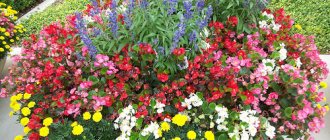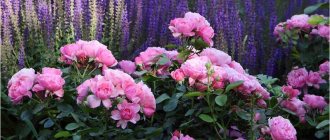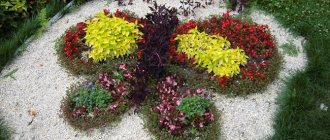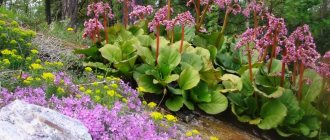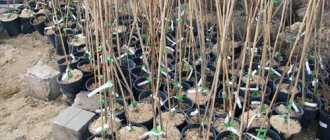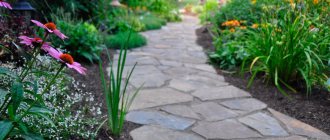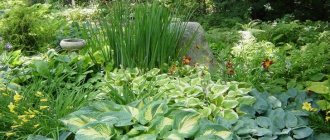Review author: Terrari School of Design
Many people try to arrange a flower bed in their garden with their own hands. This solution will allow you to beautifully and originally decorate your local area and enjoy the flowering of plants from early spring until frost. Let's look at all the secrets of designing flower beds in detail.
Selecting flower crops
To make flower beds at the dacha pleasing to the eye, it is recommended to select plants that replace each other. There are a variety of flower crops. Plants of different heights are usually selected for arranging the site.
The design of a flower bed will sparkle with new colors when choosing the following options:
- Astilbe looks attractive. It is represented by many varieties. Tall and short varieties look beautiful. Astilbe grows well in shaded areas; flowering can be admired within 7-10 weeks.
- You can't take your eyes off Helenium. The plant takes root well in the sun and shade. The crop is perennial and can withstand significant sub-zero temperatures without shelter. Helenium bushes will delight you with flowering with minimal care. They are planted in the center of the flowerbed or along the edges, depending on the design idea.
- Geranium has large inflorescences. The plant is unpretentious. Grows well. Flowers appear profusely from late spring to mid-summer.
- Catnip blooms luxuriantly. You can enjoy them in June-July. The plant is frost-resistant and does not need shelter.
- The oriental poppy looks attractive. Pleases with lush flowering with minimal care.
- The cuff is characterized by unpretentiousness. It grows to a height of 50-70 centimeters, producing lush flowers.
- Sedum multiplies quickly. Produces lush flowers with minimal care. Grows well in shaded areas.
- Rudbeckia is distinguished by its diversity. With proper care it can grow up to 2 meters in height. For this reason, it is better to plant rudbeckia in the central part of the flower beds.
There are many options for flower crops that will decorate the site in an original way. Already a photo of beautiful flower beds can attract attention. What can we say about seeing them live?
Selection and combination of plants
One of the main parameters for choosing plants for a flower garden is their height.
Tall varieties cannot be allowed to overlap the others, so they are usually planted in the center of the flowerbed or in the background.
Scheme of a flowerbed of perennials
It is better to start choosing with those varieties that will form the basis of the composition and will be its accent. These are not only tall species, but also all large and bright flowers. Then they choose background plants that complement the main ones, and also fill empty spaces and give shape to the flower garden.
When choosing a flower garden design style, it is advisable to take into account the design of the surrounding area. In terms of color, you can use both monochromatic compositions and contrasting ones. Their combinations also look beautiful.
For example, blue flowers are often lost against dark foliage. But they can be highlighted and made bright if you place plants with yellow flowers nearby.
Delphiniums in the center of the flowerbed
Some species do not combine with each other, so it is not recommended to plant them in the same flower bed. The following combinations are bad:
- peonies with any shrubs, such as roses;
- carnations and roses;
- dahlias and any cultivated plants - these flowers are used for monobeds.
And buttercup plants (anemone, delphinium, buttercup) need a lot of moisture, so any type of moisture-loving flowers does not grow well next to them.
How to preserve flower beds in the heat
Typically, flower beds are filled with plants that need the same watering regime. Therefore, they tolerate heat equally. To preserve the vitality of flowers as much as possible on such days, it is better to water them abundantly, but rarely, for example, once a week. Drip irrigation is also effective.
Drip irrigation Gardena
It is better to postpone fertilizing, as it stimulates plant growth, which requires even more moisture, which is scarce in the heat.
You can think about this issue at the stage of planning the design of the territory and organize a flower garden in a shaded place, for example, under trees. But you will also have to use shade-loving flowers for it.
Creation of regular flower beds and flower beds
To make flower beds beautiful, they are decorated, giving the area various shapes:
- One type of plant is needed to create borders. Usually low-growing flower crops are used for arrangement. Begonia looks attractive in a flowerbed at the dacha in combination with marigolds, ageratum and others. You can also use these plants to border areas with other flower crops.
- When arranging parterres, flowers grow in the form of patterns. Typically, this involves the use of bright and lush types of flowers, various landscape sculptures or fountains.
- Various options for flower bed shapes look attractive. Square, oval, triangular, and round ones are especially often arranged. Planting flowers can be in strips located next to a fence, paths or around a gazebo.
- A complex ornament made from plant crops looks original. Arabesques are especially often arranged in this way.
Flowerbeds for the lazy with the most unpretentious flowers
We looked at several options for creating the most popular flower beds.
Each of them deserves to be on your summer cottage.
But to be honest, it takes time, effort and some knowledge.
What if there is no such possibility?
This, of course, does not mean that you should not work with flowers and try to create little corners of paradise. You just need to go the simpler route until you have enough experience.
One of the solutions to this issue is shown in the video, in which the author shows how to create a flower bed that blooms all season long using simple means.
You can find out which unpretentious flowers, both annuals and perennials, are worth planting in your dacha from the article “The most unpretentious flowers for the dacha: 50 proven options.”
Rules for arranging flower beds
To arrange a flower bed, compliance with various rules is shown, which are as follows:
- selection of plants that replace each other, looking decorative and attractive;
- use of flower crops with the same requirements;
- planting varieties that are compatible in height so that they do not block each other;
- planting crops in groups depending on variety;
- using 10 types of flowers in one decorative flower bed.
Examples of beautiful flower beds at dachas
And now I suggest you look at several examples of the implementation of various flower beds in summer cottages. All of them are feasible for independent repetition. Although, of course, you will have to work hard.
How to plant flowers
The flowerbed will look attractive in the following case:
- The center is planting perennial plants, including bulbous plants. A place with a diameter of 20-50 centimeters is shown for them, which will give them the opportunity to subsequently grow.
- At the next stage, annual crops are planted. It is also necessary to leave space between seedlings. This will give them the opportunity to grow.
If unsightly bald spots appear on the site, you should fill them by planting crops. Usually the procedure is carried out 2-3 weeks after the main work in the spring, when it becomes clear what the territory will be like.
Unity of perception
A complete view of the garden takes into account many landscape elements. This means that rare bushes scattered throughout the “weave”, even the most luxurious flowers, will not create a pleasant impression. Such a “work” will look empty and frail, will not evoke the feeling of a completed composition, and will not bring the desired admiration.
It is better for the owner to choose for improvement one area that is most favorable for viewing and deal with it with the utmost care.
The purpose of beautiful flower beds is to bring aesthetic pleasure with their attractiveness and create an atmosphere of harmony and comfort. It is easier for an amateur to cope with this in one small corner than in a large area, if there is one.
Secrets of care
To improve the appearance of a landscaped flower bed, you should regularly care for the flower crops growing here.
It is recommended to water flower crops regularly. This will extend their flowering period. To carry out the procedure, it is recommended to use water that has stood for several days. Otherwise, the seedlings may get sick and die. In hot weather, it is recommended to water the plants every day. The procedure is carried out after sunset. Otherwise, the sun will burn the tender leaves of the crops.
Regular fertilizing is recommended. This will give the plants strength to grow and bloom. The soil is fertilized for the first time during the planting process. Then you should feed the plants until flowering time. Next, fertilizers are applied regularly, alternating mineral with organic.
In order for flower crops to grow better, it is recommended to regularly loosen the soil. Care must be taken when carrying out the procedure. Otherwise, you can damage the delicate root system.
Regularly remove weeds from the area. Otherwise, it will displace cultivated plants from the territory, taking away their beneficial substances.
It is necessary to treat plants with special means to prevent the development of dangerous diseases. The procedure is performed with special preparations, diluting them in accordance with the recommendations prescribed on the packaging.
With minimal care for the cultivated plants growing here, the flower beds will delight the eye for a long time. Flowers in this case will delight you with good growth and lush flowering.
What are the basic rules for forming a flowerbed of continuous flowering?
- The first and most necessary rule is that the size of a continuous flowering bed must be large , since in order for it to be a blooming oasis for a long time, it is necessary to plant many types of flowers.
- The second rule is the predominant use of perennial specimens; they are easier to care for and bloom regardless of when they are sown and when the seedlings are planted in the flowerbed.
- The third point is the choice of unpretentious flowers . This is due to the fact that each plant has its own requirements regarding soil, frequency and abundance of watering, lighting and other factors. Having planted rather capricious plants nearby, it will be difficult to achieve comfort for each of them.
- The fourth rule is to stick to a natural style with a loose fit . It is better to plant flowers not individually, but in groups, otherwise you will end up with a motley mishmash in which it will be difficult to consider each species. An exception may be large bush specimens, for example, tree peony.
- Fifth rule: choose plants for planting in the flowerbed whose foliage does not dry out or become wilted after the color ends . This will provide a bright green background for a long time, otherwise your flowerbed will look sloppy. An excellent example are the Arabis flowers, which, having stopped blooming as early as May, can remain a variegated green and white border until the autumn days.
- And finally, the sixth rule: annually “put things in order” in a flowerbed of continuous flowering, removing specimens that have already lost their decorative effect, replacing them with new ones.
Bright bloom
Photos of flower beds
Flowerbed of continuous flowering perennials: tips
- To select plants that will feel comfortable in the climatic conditions of your region, pay attention to what flowers, shrubs, and herbs are planted in flower beds in parks and squares in your locality. This selection was made by professional landscapers, taking into account the requirements of the plants.
- If you like the color scheme, you can duplicate it. For example, you planted hellebore, whose snow-white flowers look great next to blue crocuses. Feel free to plant anemones and muscari nearby, which will bloom later, while maintaining the combination of white and blue.
- Plants with variegated leaves will look beautiful either in a group or as a border. The same unpretentious coleus will save you from worries about care and will delight you with an elegant look all season long.
- The continuity of flowering of your flower bed can be ensured even in winter. To do this, you can supplement the flower garden with coniferous specimens, which will make the area green and elegant even in the winter months.
Useful articles on the site:
- Perennial dahlia flowers - planting tubers, growing
- Do-it-yourself flower beds and flower beds using improvised materials
- How to properly feed house plants
- The best perennial flowers for your garden
- Blue flowers for the garden
Small architectural forms of a summer cottage
Mafs include all structures that were described earlier in this article (swimming pools, gazebos, etc.). In addition, elements of small architectural forms are:
- flower beds and flower beds;
- decorative and artistic structures such as wells, mills, garden gnomes;
- sculptures;
- bridges;
- ponds and streams.
Old bicycle as a stand for flower pots
This list can be continued indefinitely. Garden supply stores offer a wide range of products, which are updated with new products every day. But in fact, everything that is offered on the market of folk goods can be made by yourself using available materials. Fortunately, the Internet is accessible to everyone. In its vastness you can find a lot of interesting ideas, thanks to which you will get your own original approach and develop an individual style for decorating your summer cottage.
Materials that are perfect for creating your own mafs are:
- old car tires (which you can get for free at any service station; they will thank you);
- polyurethane foam for construction;
- glass bottles of various colors and shapes;
- plastic bottles.
Sculpture from an old stump
See alsoCreating a flower garden is one of the forms of creative self-expression
Work order
At the initial stage you select:
- place for a flower garden;
- types and varieties of flowers;
- stream shape.
Small composition Source i.pinimg.com
How to make a stream of flowers is often determined by factors such as the size of the area and the desired visual effect. After this, they move on to the main work, which includes:
- Installing the prepared container in its designated place. Recommended - on a hill. It is partially dug in and gives the structure stability.
- The shape of the future flow is selected. On the ground, the future passage of the stream is marked (with all its bends) with a rope and pegs. If necessary, the future channel is deepened.
- To prevent weeds from entering the impromptu stream, it should be lined with polyethylene film.
- A soil mixture containing humus and peat is being prepared for the future flower bed.
- Choice of colors. At this stage, the type of plants and colors are selected. The best looking flowers in the stream are flowers of purple, lilac and blue shades, which spread along the ground and bloom for a long time.
Preparing the “bed” of the future stream Source diy.sndimg.com
The blue hue of flowers best imitates water Source homewikhome.com
For your information! A stream that is too small will be almost invisible in a large garden, while a stream that is too large will look unnatural.
See also: Catalog of projects of houses made of sip panels for families
Neighborhood of plants in a flowerbed
It would seem that they have decided on a place on the site, selected crops with similar requirements for humidity and light, matching in color, and also taken into account the height. Planting, care - everything is at the proper level, but the desired effect is not there: growth is weak, lush, impressive flowering is not observed.
A flower garden is an artificially created plant community in which all partners influence each other. It is important to prevent competition for conditions and plant plants that get along well with each other.
Your Majesty
This is exactly what we can call the exquisite, noble representatives of flowering perennials: rose , peony , lily . These flowers prefer open, sunny places. They are very self-sufficient: they love space and are beautiful in mono-plantings. irises are also included in this group .
Individual rose gardens or compositions involving cereals and conifers are created from rose bushes.
To protect against pests, you can plant lavender and sage next to the “queen of the garden.”
As you know, calendula and marigolds have repellent properties, but they will look very unpresentable next to a noble flower.
The peony that blooms in June is recognized as the most unique. Its magnificence is manifested not only in the large caps of flowers, but also in the spreading leaves. You can plant other plants next to the bush, but at a distance of at least 1 m.
Lilies are also good on their own, but they tolerate well the proximity to zinnias, phlox, summer dahlias, marigolds
Irises are often used by landscape designers. They can be planted in groups or as a border, and used to decorate artificial ponds and rocky gardens. They get along with lupins, violas, conifers, and ornamental grasses. Early flowering varieties look beautiful with tulips and daffodils.
Neighbors or enemies?
Among garden flowers, there are completely non-capricious species, for example, chrysanthemum , and there are intolerant ones, antagonists that inhibit the development of neighbors in the flower garden. Crops with a predisposition to the same diseases should not be planted nearby.
Plant compatibility data is summarized in the table:
| Name | Good neighborhood | Bad neighborhood |
| Rose | Conifers, grasses, silver wormwood, heuchera, lobelia, lavender, sage | Lilies, carnations, mignonette, peony |
| Peony | Daylily, astilbe, phlox, chrysanthemums, paniculate hydrangeas, clematis, hosta, mantle, nasturtium | Rose, lily of the valley, lilac, berry bushes |
| Lilies | Zinnias, perennial phlox, marigolds, annual dahlias, hostas, astilbe, delphinium, daylily, pyrethrum, yarrow | Rose, irises, chrysanthemum, tulips |
| Irises | Daffodils, tulips, heather, sedum, lupine, conifers | Rose |
| Turkish cloves | Marigolds, petunia, nasturtium, hydrangea | Rose, tulips, dahlias, gladioli |
| Lily of the valley | Forget-me-not, tulip, muscari | Peony, viola |
| Tulip | Daffodils, hyacinths, muscari, decorative onions | Lilies |
| Chrysanthemum | Asters, marigolds, cosmos, cineraria, balsam, snapdragons, ornamental cabbage, sage, cereals, sedum, ornamental grasses, conifers | — |
MAF made of polyurethane foam
Polyurethane foam is an ideal assistant in creating maf. Thanks to its resistance to precipitation, as well as lightness and strength, a springboard is created for the creation of any element of architecture. Everything depends on you.
For example, consider a craft in the form of any animal (deer, hare, etc.), which you can make yourself with your own hands. First you need to make a frame. It can be made from wooden and metal parts, using old plastic bottles. After this, polyurethane foam is applied to the frame, which is sold in any hardware store. The result is an unprocessed workpiece in the previously selected form.
Assembling a frame from plastic bottles and water pipes
We wrap the frame with isolon, which is sold in any building materials store.
If you don’t have the time and desire to breed your hare to a perfectly even state, you can make a sheep instead. The waves of foam are just like sheep's wool. The product just needs to be painted.
We apply polyurethane foam to the structure
After the foam has hardened, remove excess with a stationery knife, and then sand the surface until smooth. Next, the product is impregnated and painted in the desired color.
It is advisable to apply putty first. This will give strength and durability to the animal.
Apply façade putty
We paint with acrylic compounds, wait for it to dry and place the handsome man on our summer cottage
See also Do-it-yourself country house design from scrap materials
Mini flower beds - imagination is not forbidden
The concept of a flowerbed has expanded, and now it is proposed to make it from any object, the main thing is that soil can be poured into it. Such creative mini-flower beds look quite cute and delight with their unusualness.
The most common option is small hanging flower beds. Soil is poured into a canvas bag, leather boot, rubber boot or old mailbox and a plant, preferably a hanging one, is planted here. An impromptu flower bed is hung on a fence or wall of the house as decoration.
Non-standard flower beds are obtained using pieces of furniture. Any unnecessary thing prepared for a landfill (bed, chair, table, sofa) is placed on the lawn, partially covered with soil and planted with flowers. The same goes for leaky boats, wooden boxes, garden wheelbarrows, wicker baskets and even cars.
Using old items to create flower beds is now fashionable. But there is one drawback - under the influence of moisture, fabric and wood are destroyed. To extend the life of the flowerbed for several years, wooden parts are varnished or painted, and plastic bags are placed in leather and fabric items, and only after that soil is poured inside.
dizlandshafta
Selection of types of flowers
Creating a beautiful flower bed is a creative process that can completely absorb any gardener. This is a great way to realize your potential as a creator. By choosing the right plants for your flower beds, you can create a real living work of art on your site.
Making a flower garden from annuals
Scheme of a triangular flower bed
A huge number of seeds of all kinds of flowering plants are now sold on store shelves. Which ones are best suited for creating flower beds? First of all, focus on the growth and flowering period of plants, as well as the color of their petals.
Table. The most popular types of flower plants for flower beds .
| Name | Flowering period | Height, cm |
| Lobelia | June-September | About 15 |
| Ageratum | July-October | 15-70 |
| Iberis | June-October | Up to 40 |
| Marigold | June-September | 15-100 |
| Nasturtium | June-October | Creeping up to 400, bush 50 |
| Petunia | June-mid October | 15-80 |
| Zinnia | June-October | 20-70 |
Also, low-growing annuals include: dwarf begonia, viola, lobularia, dwarf aster; for tall ones: lupine, peony, astilbe.
raised flower bed
Prices for annual seeds
annual seeds

